
Cross County is a rural Northeast Arkansas county in the Arkansas Delta. Created as Arkansas's 53rd county on November 15, 1862, Cross County contains four incorporated municipalities, including Wynne, the county seat and most populous city. It is named for Confederate Colonel David C. Cross, a political leader in the area.

Central Office Building is a historic building located in downtown Davenport, Iowa, United States. It has been individually listed on the National Register of Historic Places since 1983. In 2020 it was included as a contributing property in the Davenport Downtown Commercial Historic District. It is located in the center of a block with other historic structures. It now houses loft apartments.
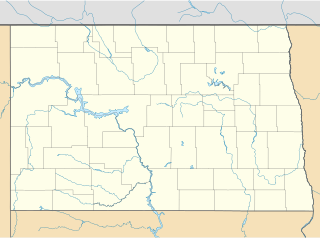
The Flatiron Building was an historic building in Grand Forks, North Dakota, that was built in 1906 and was destroyed by the 1997 Red River flood. It was listed on the National Register of Historic Places, but was removed from the Register in 2004 because it had been destroyed.

Wheeling Warehouse Historic District is a national historic district located at Wheeling, Ohio County, West Virginia. The district includes 20 contributing buildings and 11 contributing structures. They are warehouses and commercial style buildings and structures between Main Street and the Ohio River. All of the buildings date to the late-19th and early-20th century. The warehouses are mostly two- and three-story masonry buildings. The two-story commercial buildings have storefronts on the first floor and residential units above. Notable buildings and structures include the Pump Store (1933), Wheeling Stamping Plant (1932), Allied Plate Glass, Warwick China, Boury Warehouse, Ott-Heiskell Company, Edward Wagner Wholesale Grocers building (1915), the Moderne style former Greyhound Bus Station, and Main Street Bridge (1891).

The Standard Ice Company Building is a historic commercial building at 517 South Main Street in downtown Stuttgart, Arkansas. Constructed in 1926, the building is in the Spanish Revival style, with a tile roof and glazed brick façade. The company manufactured blocks of ice for commercial and residential use, and remained in business until 1978. As household refrigerators became widespread, the facility was used to freeze and pack strawberries, as well as process and freeze ducks killed by local hunters.
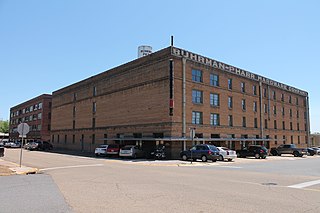
The Buhrman–Pharr Hardware Company Historic District encompasses a pair of brick commercial buildings on 3rd Street in Texarkana, Arkansas. The two four-story structures, located on the block between Laurel and Ash Streets, were built in 1914 and 1923 for the Buhrmann–Pharr Hardware Company, a significant force in the economic development of Texarkana for more than a century. The company was founded in the late 1880s by W. J. Buhrman and J. L. Chatfield, the interest of the latter being taken over by F. E. Pharr in 1908. Started as a modest retail establishment, the company grew to become one of the region's largest wholesale supplier of hardware and agricultural implements. These two buildings were built to address the company's growth in the first decades of the 20th century. The wholesale business was closed in 2001 and the retail establishment shut down two years later.

The Stuttgart Commercial Historic District encompasses a portion of the commercial center of Stuttgart, Arkansas. The district extends along Main Street between 1st and 6th Streets, and includes a few buildings on the adjacent numbered streets as well as Maple and College Streets, which parallel Main to the west and east, respectively. The majority of the district's 76 buildings were built between about 1900 and 1920, and are brick commercial structures one or two stories in height. Notable among these buildings are the Riceland Hotel, the Standard Ice Company Building, and the county courthouse.

The Wynne Commercial Historic District encompasses the historic early 20th century business district of Wynne, Arkansas. It is bounded on the west by Front Street, on the north by East Commercial Street, on the south by East Pecan Street, and roughly on the east by South Wilson, East Union, and South Terry Streets. This area was developed beginning with the arrival of the railroad in 1882, but a fire destroyed most of the center in 1887. Consequently, most of the development in this area began in 1891 and was mostly built out by 1959. The architecture in this area is largely early 20th-century brick commercial architecture, with some buildings exhibiting stylistic flourishes from the Italianate, Mediterranean, and Romanesque Revivals.

The John H. Johnston Cotton Gin Historic District encompasses a historic cotton gin in the small community of Levesque, Arkansas. The main building of the gin was built in 1941, and was built out of reinforced concrete, instead of the more usual steel, owing to a metal shortage in World War II. It has some Moderne styling, with smooth surfaces and rounded corners. The gin also distinctively incorporates a seed storage facility at its rear. Its ancillary structures, which include a shed, privy, and cyclone structure, are wood-framed with metal siding and roofing.

The Lepanto Commercial Historic District encompasses the traditional commercial heart of the small city of Lepanto, Arkansas. The district includes one block of Greenwood Avenue between Berry and Holmes Streets, and portions of two more blocks at either end, as well as two blocks of Berry Street, with a few buildings on adjacent streets. Lepanto was founded in 1903, but its surviving commercial architecture only dates as far back as c. 1915, when the Portis Company cotton gin was built at the eastern end of the district. Other early buildings include the triangular {{circa|1920} Arlington Light and Power building at 320 Greenwood, and the unusual Barton's of Lepanto building at 111 Berny Street, built as a wood frame lumber yard office {{circa|1920); its walls were bricked in 1955 when it was converted to a hardware store.
The Piggott Commercial Historic District encompasses the original center of the city of Piggott, Arkansas, as originally platted out in 1887. It is centered on the square where the Clay County courthouse is located, buildings facing the courthouse square, and also buildings along some of the adjacent streets. In addition to the courthouse, the district includes the c. 1910 railroad depot, city hall, two churches, the 1930s Post Office building, a cotton gin, and a grain storage yard. The town grew because of the railroad, and the plentiful timber in the area, whose harvesting fueled the early economy in the region. The oldest building in the district is the 1897 Clay County Bank at 188 West Main Street.
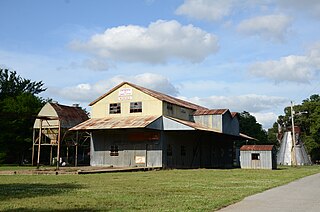
The Weldon Gin Company Historic District encompasses a historic cotton gin complex in Weldon, Arkansas. With a history dating to 1833, the Weldon Gin Company was long a staple of the local economy. Located in the center of the town at the junction of Weldon and Washington Streets, the company complex includes a main gin building, built in 1939, and four outbuildings. The present mill was built to replace an earlier steam-powered mill after electricity was introduced to the area in the 1930s.

The Hanger Cotton Gin is a historic cotton gin in Sweet Home, Arkansas. Built about 1876, it is a rare surviving example of a steam-powered gin. The main building is a three-story frame structure covered in board-and-batten siding. The gin was only operated commercially for a brief period, and was out of service by 1892. Since then, the building has been used as a barn and grain storage facility. It was probably built by Peter Hanger, whose family has been prominent in the Little Rock business community since that time.

Lagomarcino-Grupe Company, also known as Rand & Coolbaugh's Block, is a historic building located in the central business district of Burlington, Iowa, United States. It was individually listed on the National Register of Historic Places in 2013, and it was included as a contributing property in the Downtown Commercial Historic District in 2015.

The Keo Commercial Historic District encompasses a cluster of commercial and industrial buildings that make up the economic center of the small city of Keo, Arkansas. The district includes a two-block section of Main Street, anchored at its southern end by the Cobb Cotton Gin complex, and on the north by Arkansas Highway 232, where it extends a short way in both directions. The community grew around the Cotten Belt Railroad line, which Main Street was laid out just west of. The cotton gin complex has its origins in 1906, as a means for local farmers to process their cotton and send it on to market via the railroad.

Bloomington West Side Historic District is a national historic district located at Bloomington, Monroe County, Indiana. The district encompasses 394 contributing buildings, 2 contributing sites, and 2 contributing structures in a mixed residential, commercial, and industrial section of Bloomington. It developed between about 1850 and 1946, and includes notable examples of Queen Anne and Bungalow/American Craftsman style architecture. Located in the district are the separately listed Elias Abel House, Cantol Wax Company Building, Coca-Cola Bottling Plant, Cochran-Helton-Lindley House, Illinois Central Railroad Freight Depot, Johnson's Creamery, and Second Baptist Church. Other notable contributing resources include the Works Progress Administration constructed wading pool, White Oak Cemetery, Ninth Street Park, Bloomington Wholesale Foods Warehouse, Bloomington Garage, Curry Buick, Banneker School, Bethel African Methodist Episcopal Church, and Bloomington Frosted Foods.
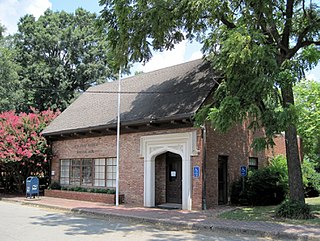
The Willson Commercial Historic District encompasses the commercial and industrial heart of Wilson, Arkansas. Founded in 1886 as a company town by Robert Edward Lee Wilson, the city's growth was regulated and planned by the company until it was formally incorporated in 1950. This district encompasses the historic town square, commercial buildings, and the administrative and industrial buildings of the company's cotton gin and flour mill.

The Taft–West Warehouse, also known as the C.C. Taft Company Building, Plumb Supply Company, Ben's Furniture Warehouse, and Nacho Mamma's, is a historic building located in Des Moines, Iowa, United States. Completed in 1923, this three-story brick structure was built during a transitional period between the dominance of railroads the emergence of trucks servicing warehouses. It was designed by local architectural firm of Vorse, Kraetsch, & Kraetsch. It features cleans lines of the Commercial style as opposed to the fussiness of late Victorian styling that was dominant in a great deal of the city's commercial architecture. The building was also located in the Court Avenue wholesale district, and now it is only one of only five or six that remain extant. The building was constructed for the C.C. Taft Company. This firm and the O.B. West Company that succeeded it in this building, dealt in wholesale fruits, vegetables, candy and tobacco. The building was listed on the National Register of Historic Places in 2006.

The Waterloo East Commercial Historic District is a nationally recognized historic district located in Waterloo, Iowa, United States. It was listed on the National Register of Historic Places in 2011. At the time of its nomination the district consisted of 36 resources, including 28 contributing buildings, and eight non-contributing buildings. The city of Waterloo was established in the early 1850s. Its first settlers started developing the west side of the city before crossing the Cedar River and developing east side. The first Black Hawk County Courthouse was built on the east side in 1856 and East Waterloo Township was created two years later. As industry began to develop along the river, and the arrival of the first railroad in 1861, the commercial district on the east side began to grow. Also on the east side of town was the terminus of the streetcar-turned-interurban system. By 1900, the city became one of the primary wholesale and retail centers in northeastern Iowa. In 1911 the Black population increased significantly as workers, primarily from Mississippi, moved into town to work for the Illinois Central Railroad. The following year the saloons in town were closed and bootlegging, gambling, drugs, and prostitution started to increase in the area surrounding the central business district. All of these developed put together created the atmosphere of the downtown commercial district.
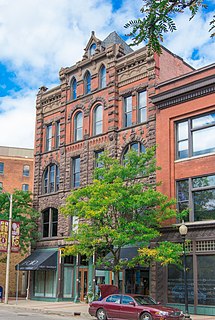
For other Haymarket districts see Haymarket District (disambiguation)





















